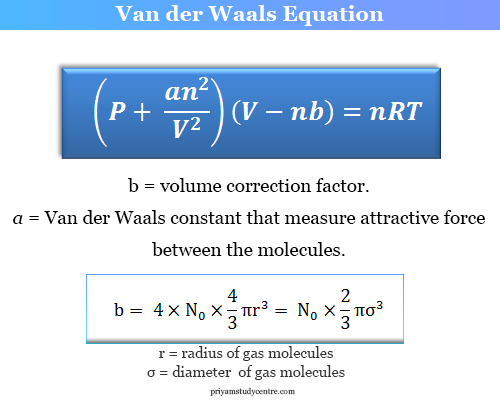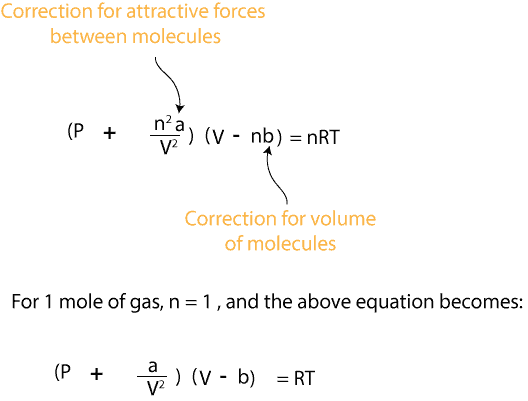Van Der Waals Equation Used to Describe Real Gases
This law predicts the properties of real gases by describing particles of non-zero volume governed by pairwise attractive forces. The van der Waals equation is frequently presented as.

Van Der Waals Equation Derivation Formula Units Chemistry
Ideal gases are based on the assumption that the gas molecules.

. The improved fit is obtained by introducing two parameters designated a and b that must be determined experimentally for each gas. Since van der Waals first suggested a way of extending the equation of state for an ideal classical gas to apply to real ones there have been many other equations proposed including those of Dieterici Berthelot and Callendar with some aimed at improving on van der Waals original equation and others empirically based and designed to suit particular gases or. The ideal gas law equation is an equation used for analyzing ideal gases.
Is the temperature P. Which of the following statements explain why the van der Waals equation must be used to describe real X. The equation is given by.
The Van der Waals equation is the equation of state of real gases named after its discoverer the Nobel physics prize winner Johannes Diderik Van der Waals. The Van der Waals equation is the next one. A modification to the attraction term in the PengRobinson equation of state published by Stryjek and Vera in PRSV significantly improved the models accuracy by introducing an adjustable pure component parameter and by modifying.
The excluded volume of gas particles and attractive forces between gas molecules. The Van der Waal equation can be given as below. According to the kinetic molecular theory that defines an ideal gas no ideal gases exist in nature only real gases.
We can use the van der Waals equation to plot isotherms for real gases. These generally take account of higher-order nonlinear attractive forces and require the use of more empirical constants. It takes into consideration the molecular size of the gas-particle and.
Where p is the pressure V is the volume T is the temperature n is the number of moles of gas present R is the gas constant and a and b are experimental constants that depend upon the gas. Van der Waals equation for real gases is the corrected form of ideal gas equation which includes the effects of intermolecular forces of attraction and space occupied by gas molecules. In the van der Waals equation the constant a is a correction term for intermolecular force and b is a correction for the real volume of the gas molecules.
More elaborate equations are required to describe the behavior of gases over wider pressure ranges. The molecular attractions between particles of gas decreases the pressure. P V - nb nRT There are two corrective factors in van der Waals equation.
The two equations are presented below. To describe the real gases Van der Waals equation is used. It accounts for the intermolecular attractive forces between gas molecules.
That means pressure of real gas is less than the ideal gas. Describe the type of gaseous molecules that are most susceptible to nonideal behavior. The van der Waals equation of state is.
The relationship between gas mass m gas volume V gas temperature T and the resulting gas pressure p is described by the so-called ideal gas law in which R m denotes the universal gas constant which is independent of the type of gas. To recall the equation is P aV2 V - b RT where P is pressure V is volume T is temperature R is the universal gas constant and a and b are constants that are determined experimentally and are dependent on the gas. Van der Waals equation is an attempt to make corrections to real gases that do not exhibit ideal behavior.
These are used to as corrections of the ideal law equation. Is the moles of the gas R. The van der Waals equation is only one of many equations of state for real gases.
P an2 V 2V nb nRT P a n 2 V 2 V n b n R T. PV n R T. The first alters the pressure in the ideal gas equation.
P n²aV² V-nb nRT PVTR have the same meanings as other equation. Here we see P of previous gas equation is replaced by P - a V². 1 The ideal gas law is the following.
The constants a and b represent the magnitude of intermolecular attraction and excluded. Intermolecular forces are often lumped together and called van der Waals forces in. Van der Waals A modification to the ideal gas law that can be used to correct for the intermolecular forces and molecular volumes in determining the moles of gas present in the system.
The van der Waals equation modifies the ideal gas law. This law predicts the properties of real gases by describing particles of non-zero volume governed by pairwise attractive forces. The van der Waals equation is an equation of state that corrects for two properties of real gases.
Real Gases The van der Waals equation corrects for the volume of and attractive forces between gas molecules. The non-zero volumes of gas particles effectively decrease the amount of empty space between them Z. Van der Waals equation is 2121 P a n 2 V 2 V n b n R T It fits pressure-volume-temperature data for a real gas better than the ideal gas equation does.
The van der Waals equation of state is written as. P a n 2 V 2 V n b n R T. Is the gas constant T.
It is an equation used to describe the behaviour of gases in conditions of temperature T and pressure P over a wider range than for ideal gases for a volume V occupied by n moles. The excluded volume of gas particles and attractive forces between gas molecules. 1 p V n R m T ideal gas law.
We do not go into deriving van der Waals equation now but we can express it as p a n2 V 2V nb nRT 3 3 p a n 2 V 2 V n b n R T. This is called van der Waals equation. The van der Waals equation is frequently presented as.
This leads to lesser collisions with the container and a lower pressure than that is expected from the ideal gas. If the calorically perfect gas approximation is used then the ideal gas law may also be expressed as follows. In the usual situation a and b are known and.
A is the experimental value that represents the intermolecular fores of the vapor. Is the volume of the container and a. P a nV2 Vn b nRT Here a is a constant that depends on the type of gas and b is also a constant that gives the volume per mole of gas occupied by the molecules of gas.
It is due to mutual attraction between any two gas molecules. Interactions between gas molecules reduces the temperature of the gas in the sample Y. P V 2a VbnRT where P is pressure V is volume R is universal gas constant and T is absolute temperature.
For a real gas containing n moles the equation is written as. P a n 2 V 2 V n b n R T. The van der Waals equation modifies the ideal gas law.
Is the measured pressure V. Van der Waals equation is a modification of the original ideal gas law. This is for one mole.
P - a V² V - b R T a and b are constant and depend upon nature of gas involved. The van der Waals equation is an equation of state that corrects for two properties of real gases. In chemistry and thermodynamics the Van der Waals equation or Van der Waals equation of state is an equation of state which extends the ideal gas law to include the effects of interaction between molecules of a gas as well as accounting for the finite size of the molecules.
P V n R T. Van der Waals equation is an equation relating the relationship between the pressure volume temperature and amount of real gases.

Van Der Waal S Equation And The Significance Of The Constants A And B

Van Der Waals Equation Real Gases Video Lesson Transcript Study Com

Real Vs Ideal Gases Van Der Waals Explained For General Chemistry Youtube
Comments
Post a Comment